Grace upon Grace
Students look up and read several passages about grace. The worksheet asks students to identify the purpose of grace in each and summarize the ways grace is present in their own lives.
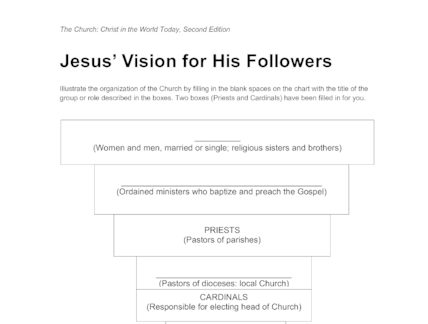
This activity asks students to illustrate the organization of the Church by filling in the title of the group or role described in each box.
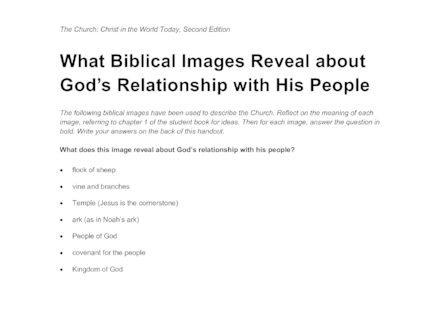
Students will examine seven different images of God’s people used in the Bible, and describe what each image reveals about God’s relationship with his people.
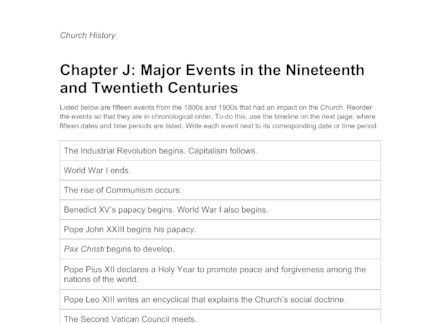
Students order important events from the 19th and 20th centuries.
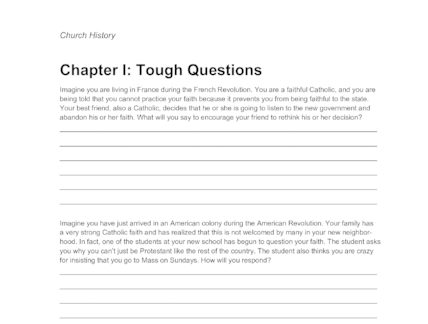
The worksheet poses several questions that ask students to reflect on how they would have stood up for their faith during the French and American Revolution.
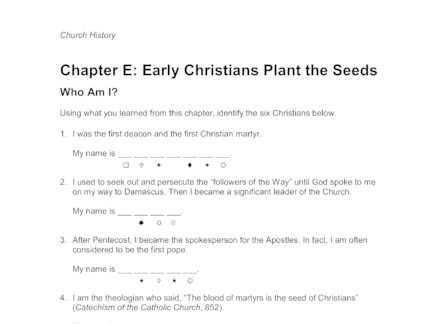
On this worksheet, students solve clues to list the names of important early Christians. These answers are then used to decode a secret message.
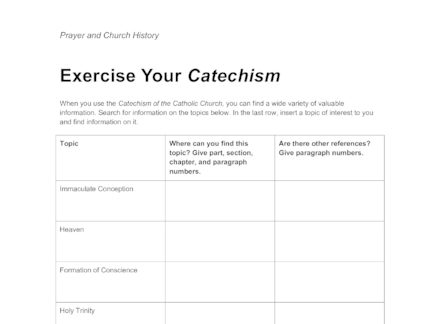
This handout guides students as they become familiar with searching for information in the Catechism of the Catholic Church.
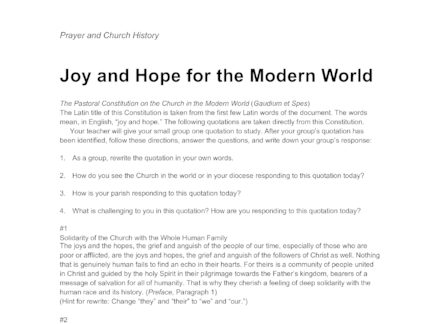
This handout provides questions for students to reflect on and answer as they read quotations from this Constitution.
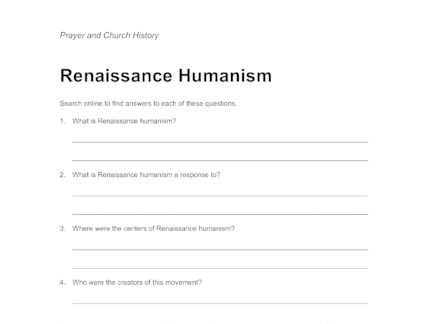
This handout provides questions for students to research on the Internet about Renaissance Humanism.
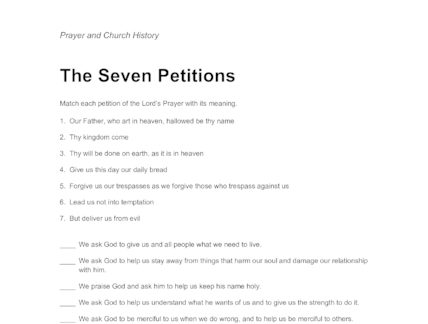
On this handout, students match the meaning to each line of the Lord’s Prayer.
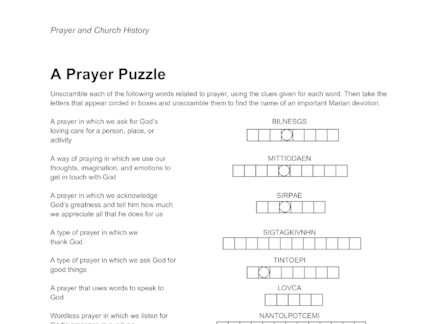
On this handout, students must use clues to unscramble words related to prayer.
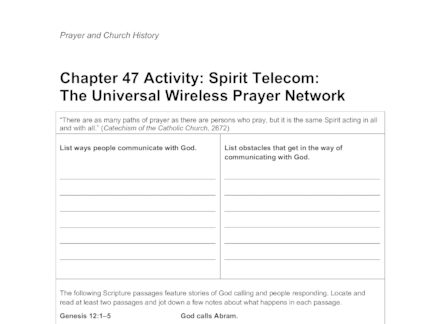
This handout guides students as they locate and read various Scripture passages focusing on the many way God calls us to prayer.
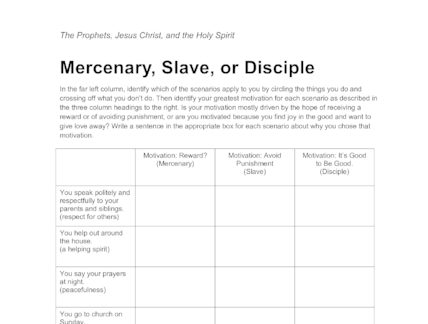
Students identify their motivation for doing good deeds before reflecting on the role of grace in their lives.
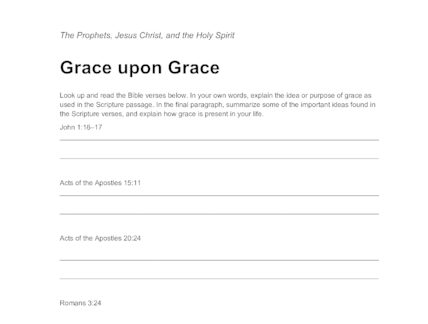
Students look up and read several passages about grace. The worksheet asks students to identify the purpose of grace in each and summarize the ways grace is present in their own lives.
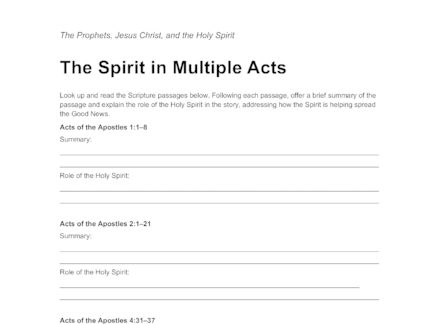
Students look up and read several passages that the Holy Spirit. The worksheet asks students to summarize each passage and describe the role of the Holy Spirit in spreading the Good News.
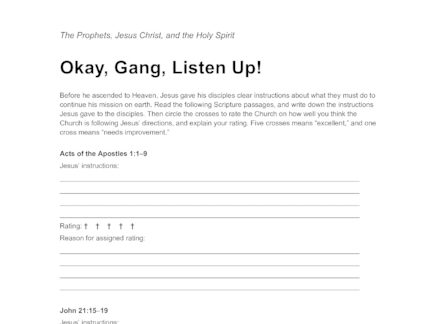
Students look up and read several passages that highlight Jesus’ instructions to his disciples. This worksheet then challenges students to reflect on how well the Church is following the instructions today.
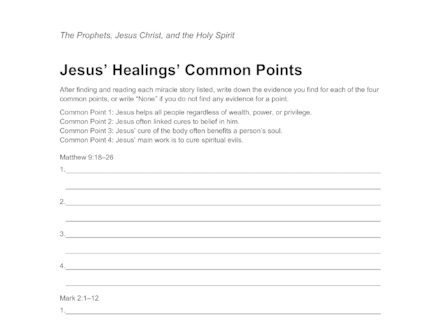
Students look up and read several miracle stories from the New Testament before identifying common points between them.
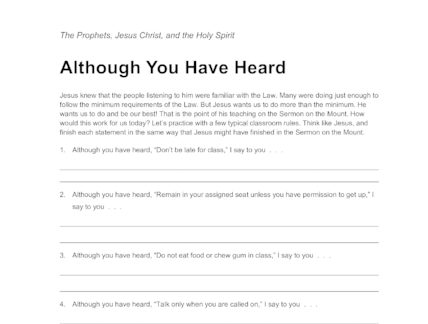
Students rewrite classroom rules modeling their responses after Jesus’ Sermon on the Mount.
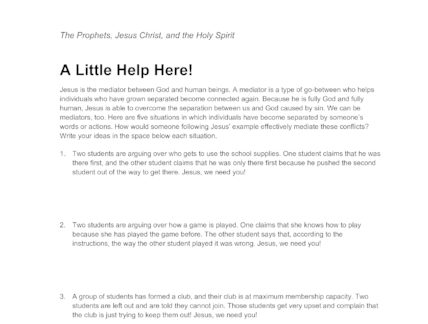
After reading several real-life examples of conflict, students provide suggestions to mediate each situation.
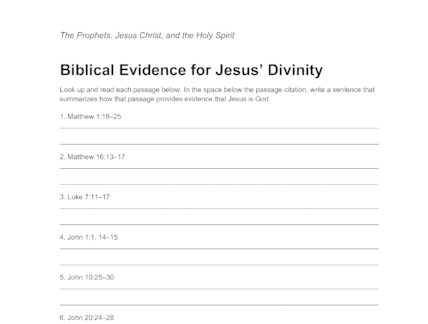
Students look up, read, and examine Scripture passages that provide evidence that Jesus is God.
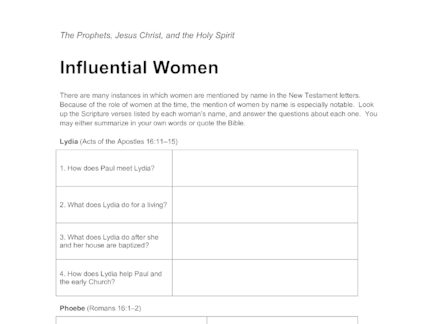
Students look up, read, and answer questions about Scripture passages that note influential women in the New Testament.
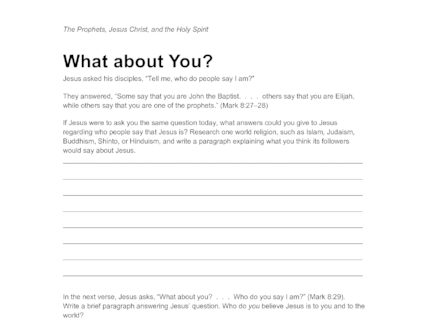
After reading Mark 8:27-29, students must answer several questions about who Jesus is to today’s world and people.
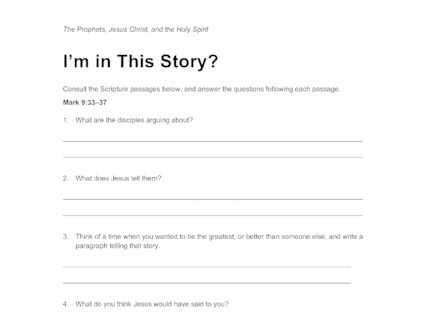
Students must look up several Scripture passages that give insight into the disciples of Jesus. This worksheet poses questions that help make Jesus’ mission relatable to students.
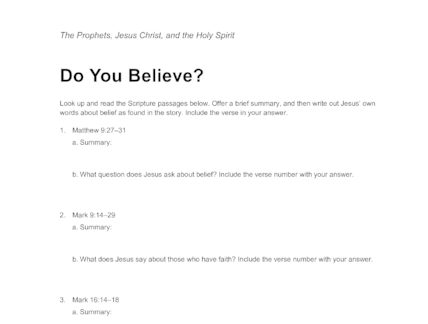
For this worksheet, students look up Scripture passages that examine the words and beliefs of Jesus in each story.
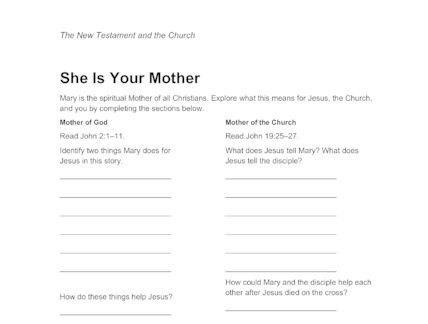
As students complete this worksheet, they will explore what it means when we say that Mary is the Mother of God and the Mother of the Church.
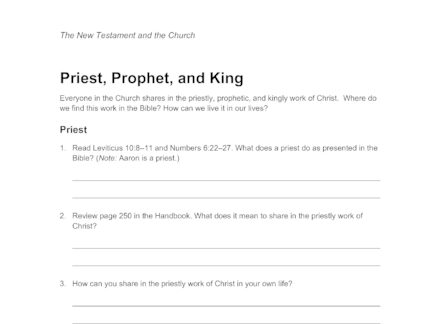
Students find examples in the Bible of the priestly, prophetic, and kingly work of Christ before applying it to their own lives.
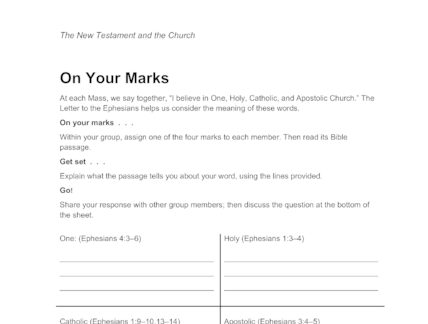
This worksheet guides group members to work together as they identify the importance of the church being “One, Holy, Catholic, and Apostolic”.
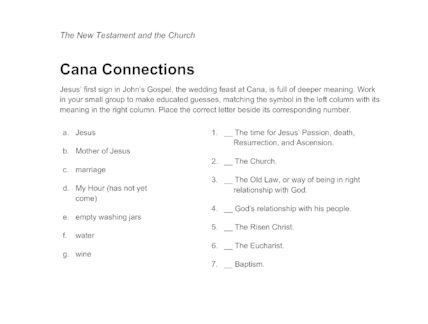
Students match symbols from Jesus’ first miracle the wedding feast in Cana with their meaning and significance.
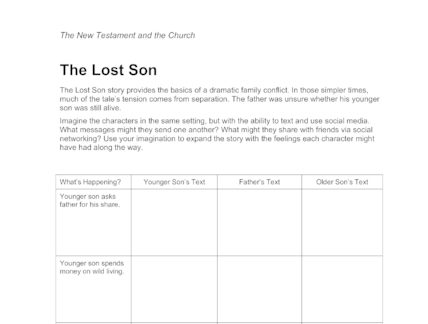
On this worksheet, students retell the story of the Prodigal Son using texting and social media messages.
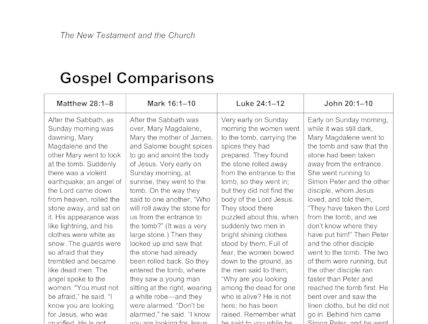
On this worksheet, students read all four Gospel accounts of the resurrection before identifying similarities and differences between them.
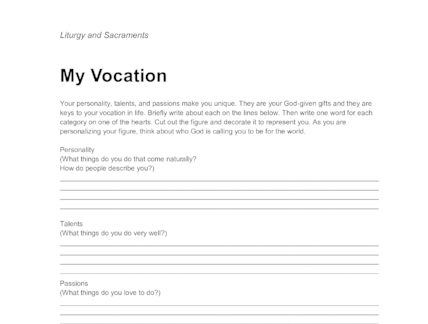
This handout helps students identify their talents, gifts, and personality and how these fit into God’s vocation for their lives.
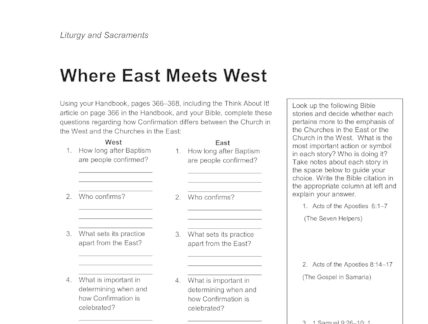
This worksheet guides students to make connections between Confirmation in the Eastern and Western Churches.
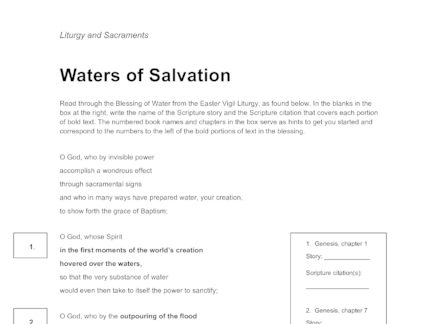
On this worksheet, students identify the Scripture passages associated with the various parts of the Blessing of the Water used at the Easter Vigil.
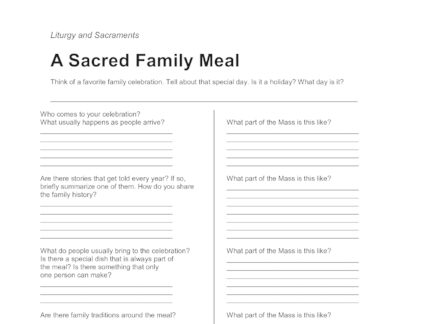
This worksheet guides students to make connections between the Mass and a special meal or tradition in their family.
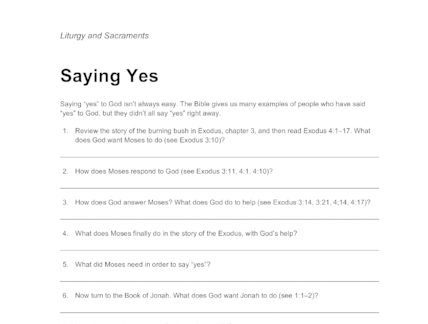
This handout guides students to examine several Scripture passages exemplifying what it means to say “yes” to God’s call.
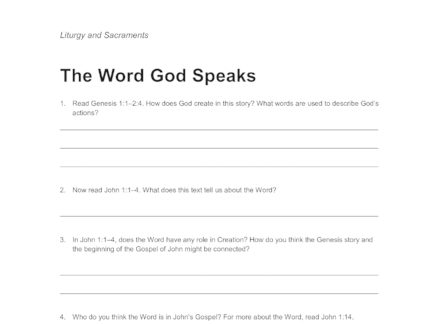
This worksheet helps students to explore the meaning of “the Word” in John’s Gospel and throughout Scripture.
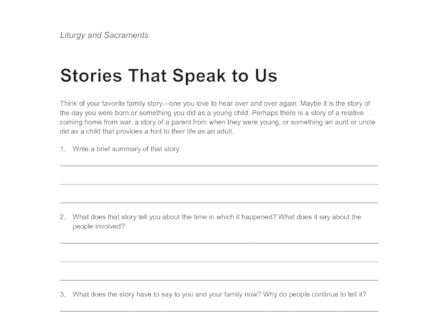
This handout guides students to recognize the importance of stories, both in our families and our faith.
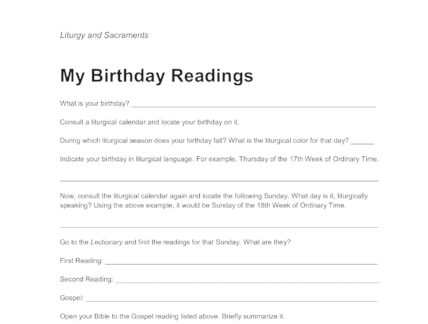
Students identify the liturgical season in which their birthday falls. This worksheet then guides them to identify and summarize the readings for that day.
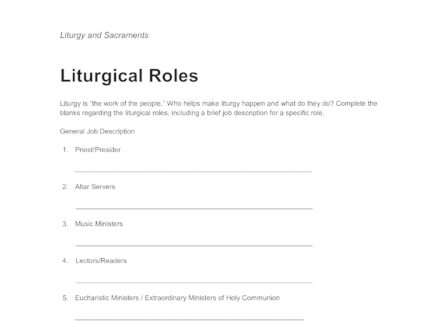
This handout asks students to identify the role of the various liturgical ministers at Mass.
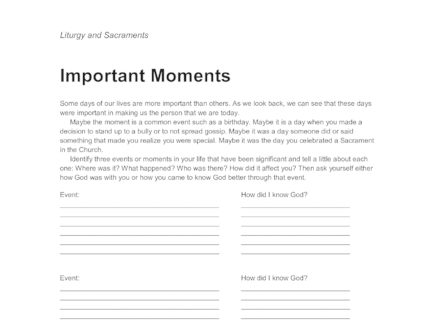
This handout asks students to think about and reflect on moments in their life that have been significant.
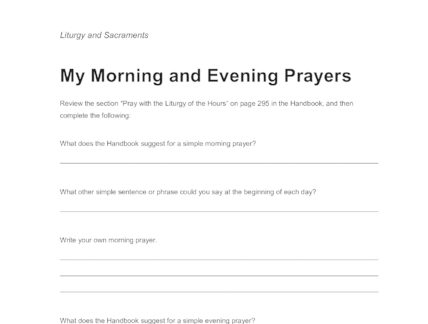
This handout asks students to think about the Liturgy of the Hours before they answer questions about and create their own morning and evening prayers.
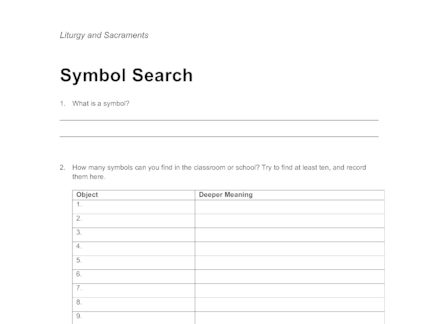
This handout challenges students to find symbols in their classroom or school and identify the deeper meaning of each.
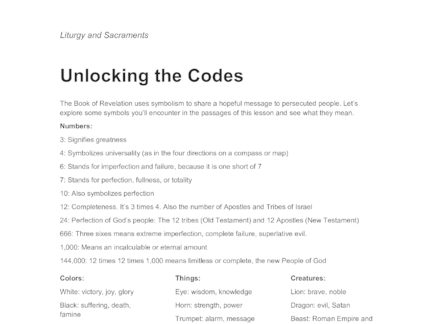
This handout provides several short activities for students to complete as they learn about the symbolism of the Book of Revelation.
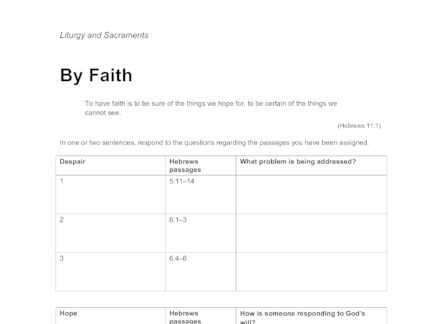
This worksheet guides students to read numerous passages from the Bible regarding despair, faith, and hope. Students are then asked to draw connections between the passages and heroes.
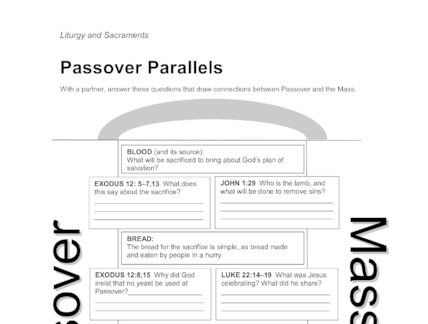
This partner worksheet helps students draw connections between Old Testament passage about the Passover and New Testament passages about the Mass.
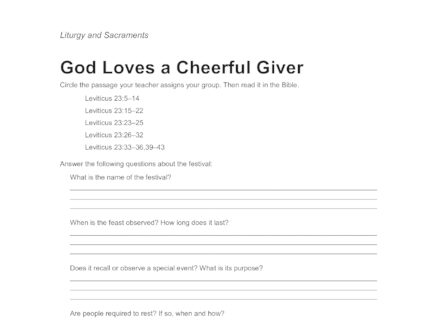
This worksheet guides students to read and answer questions about a specific Hebrew festival from the book of Leviticus.
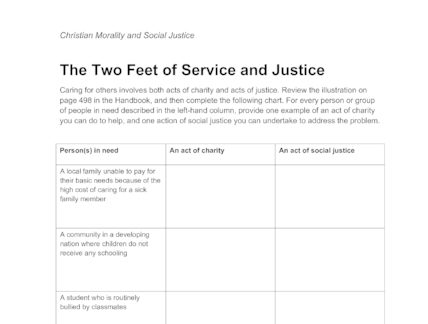
This chart provides students space to create examples of acts of charity and social justice for several real-life situations.
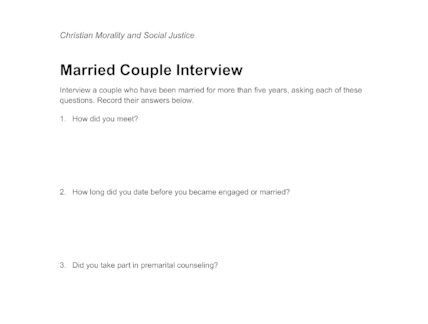
This handout provides the outline for an interview of a married couple.
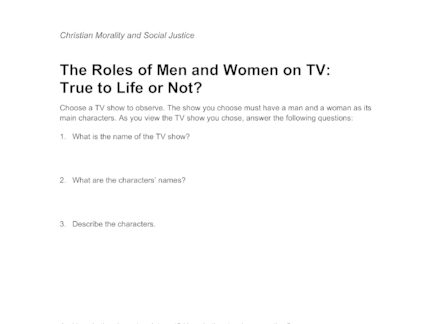
This handout provides questions for students to answer as they observe the roles of men and women on TV.
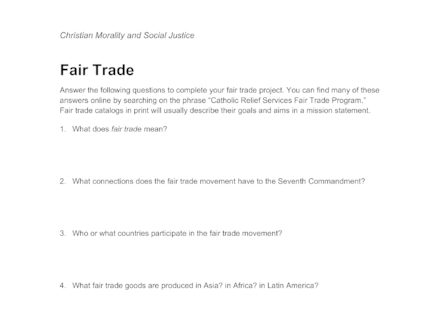
This worksheet provides questions for students to answer as they research and learn about the Fair Trade Movement.
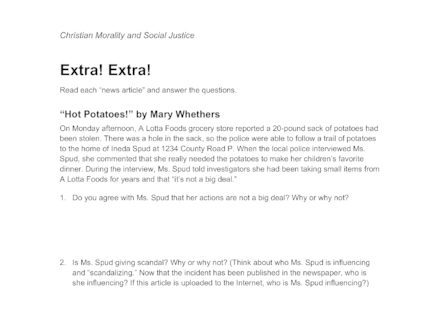
Students read two “news articles” and evaluate the morality of each by answering a series of questions.
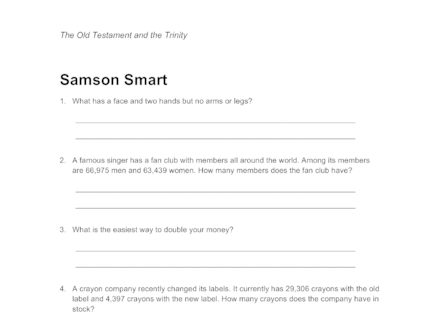
This is a set of riddles to challenge students as they learn about Samson in the Old Testament.
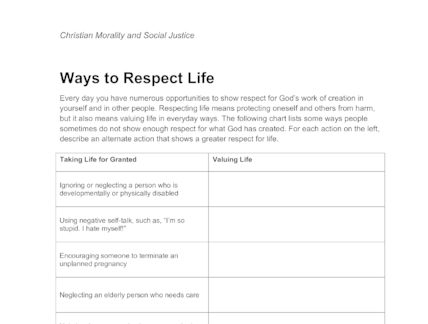
This worksheet challenges students to think about how they can value the dignity of life on a day-to-day basis.
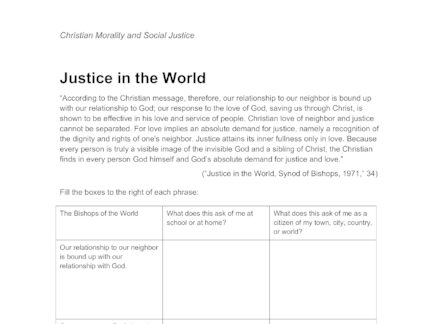
This worksheet challenges students to think about how the teachings about Justice from the Bishops of the World apply to their daily lives.
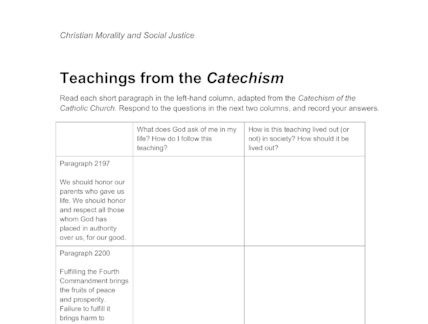
This worksheet challenges students to think about how the teachings from the Catechism on the fourth commandment apply to their daily lives.
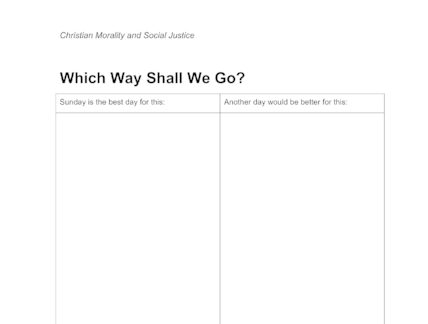
This handout provides a chart for students to list activities that are best to do on Sunday and those that should be saved for other days of the week.
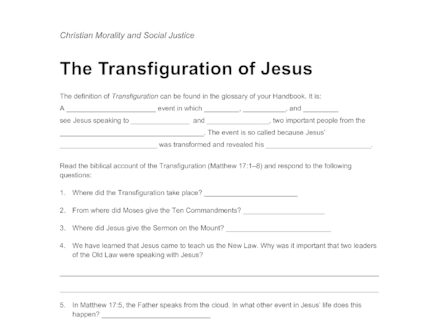
This worksheet helps students to read Scripture passages, answer questions about, and understand the importance of the Transfiguration of Jesus.

This worksheet guides students as they look up Scripture passages that give moral advice.
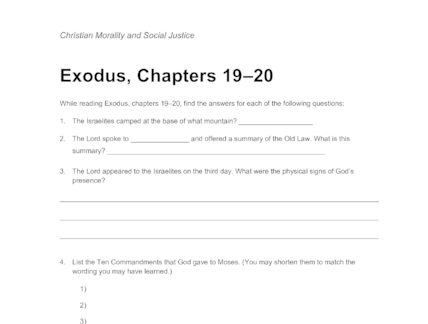
This handout provides a note-taking guide while reading chapters 19-20 from Exodus.
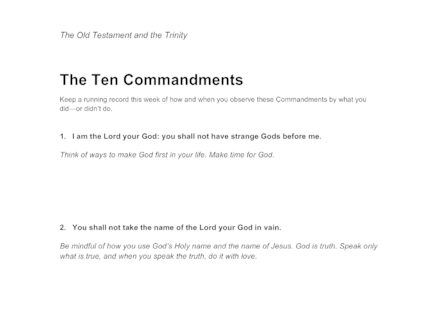
This handout asks students to keep a running record of how they observe the Ten Commandments in their actions throughout a week.
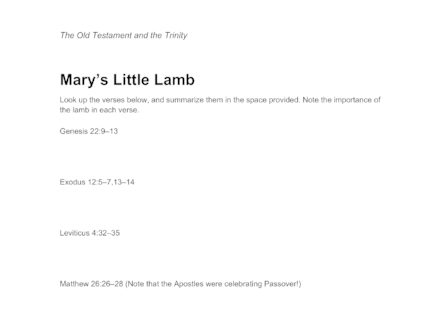
This worksheet helps students to reflect on the numerous images of the lamb found in Scripture.
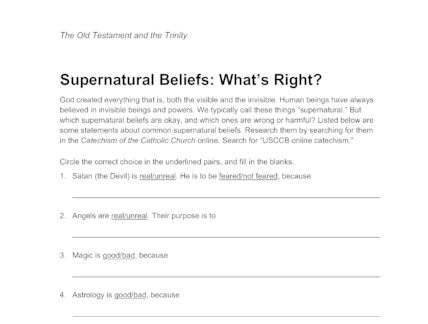
This worksheet guides students to identify and research Church teachings on supernatural beings.
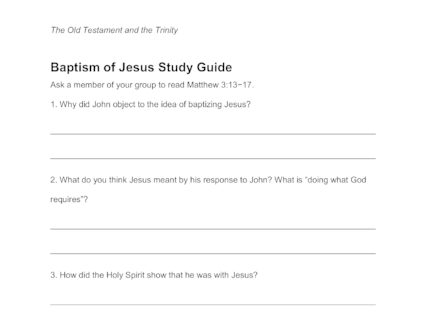
This study guide helps students reflect on the story of Jesus’ Baptism.
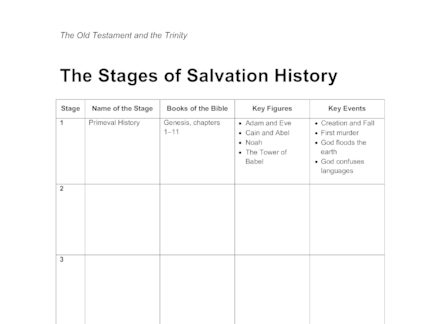
This chart allows students to organize information about the stages of salvation history.
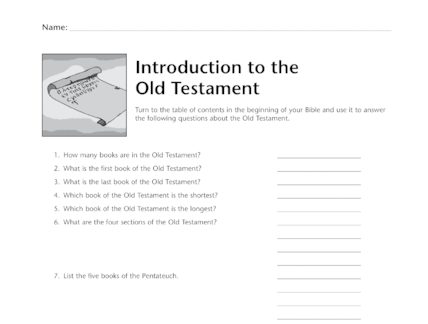
This worksheet guides students to explore and become familiar with the sections of the Old Testament.
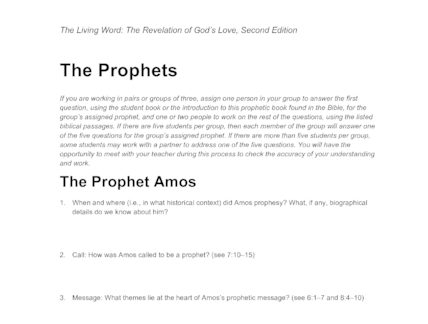
This small-group activity provides questions for students to answer about the different prophetic books of the bible.
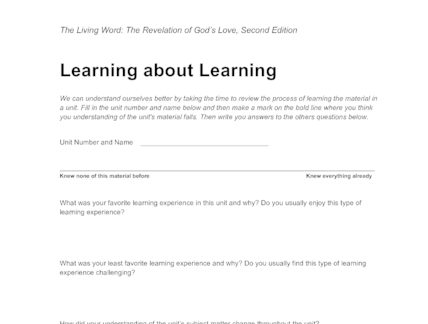
This is a self-evaluation to help students reflect on their learning during Unit 1.
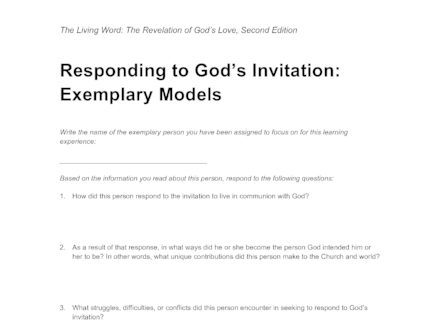
This project asks students to research an exemplary model of what it means to be the best person that God created each of us to be.
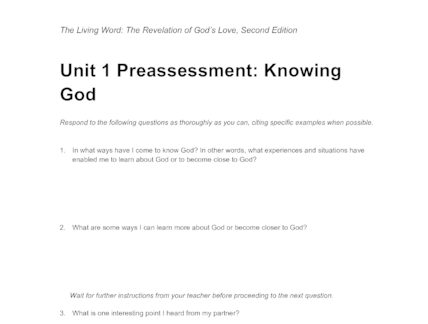
This preassessment poses questions about how students have come to know God.
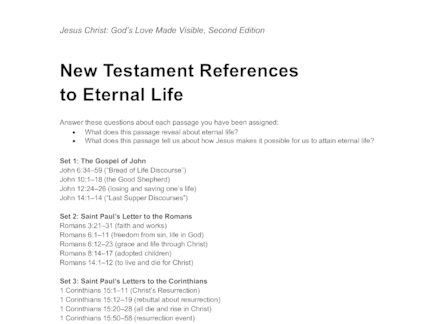
This handout lists Scripture passages to be read by students that reference eternal life and how Jesus makes it possible for us to attain it.
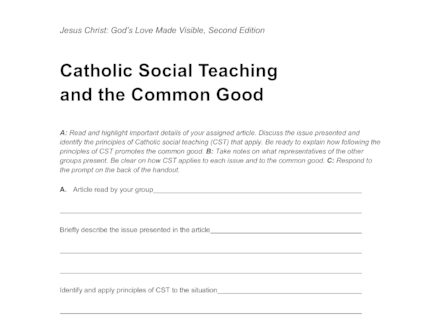
This worksheet helps students to take notes as they read articles and make connections to the principles of Catholic Social Teaching.
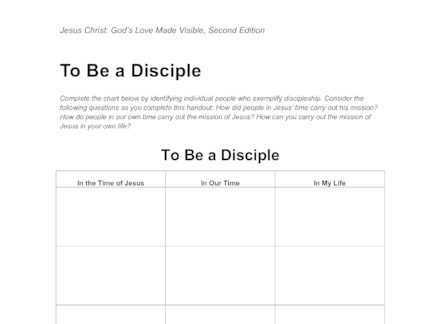
This handout asks students to complete a chart by listing examples of discipleship at the time of Jesus and today.
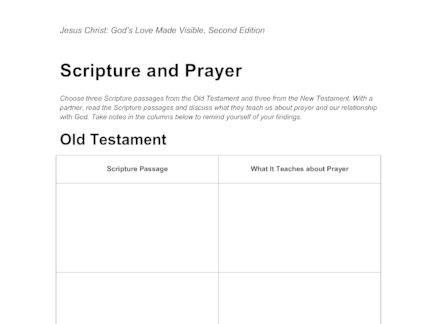
On this worksheet partners choose three scripture passages from both the Old and New Testaments. They then note how what each passage teaches about prayer and our relationship with God.
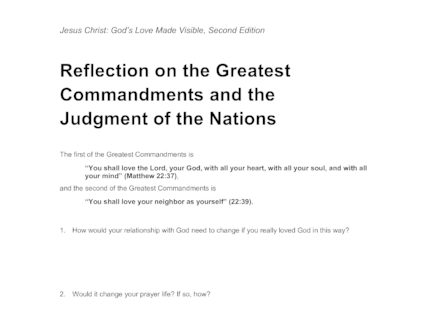
This handout challenges students to reflect on the application of the greatest commandment in their own lives.
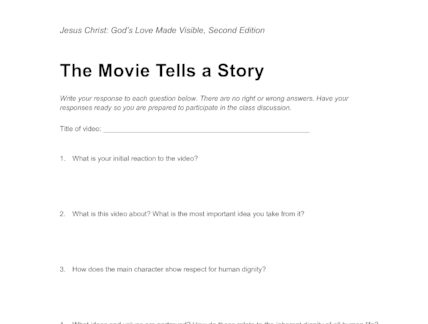
This worksheet provides questions for students to reflect on and answer while watching a movie.
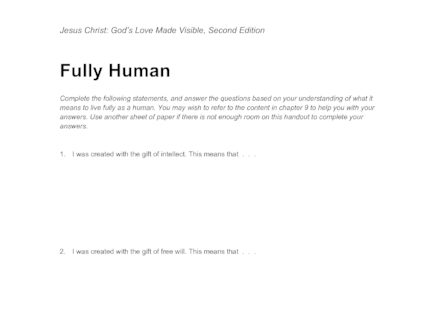
This handout poses questions and gives statements that challenge to think about what it means to be fully human and how Jesus exemplified that in his life.
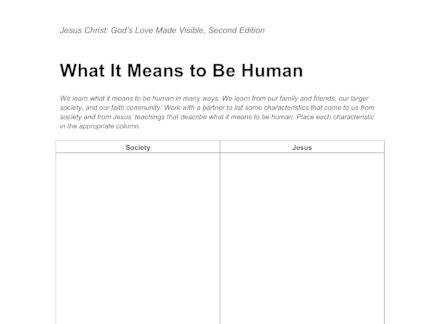
This handout helps students list characteristics that come from society and from Jesus’ teachings that describe what it means to be human.
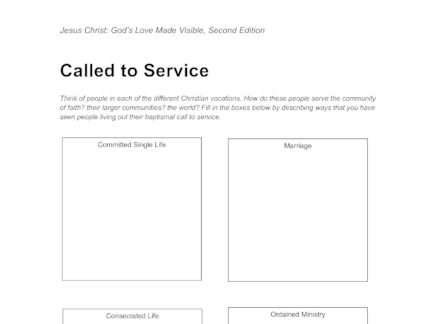
This handout asks students to list examples of people in their lives that are serving the community in the various Christian vocations.
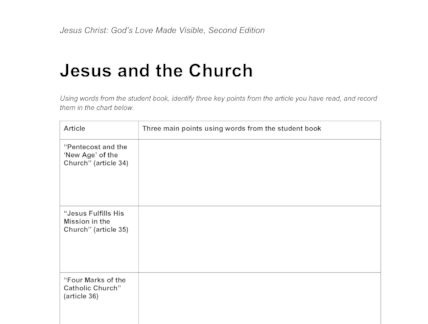
After reading several articles, students complete this chart by filling in key points about Jesus and the Church.
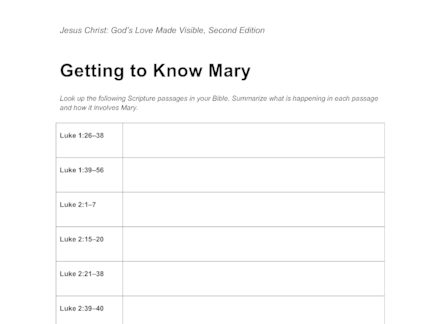
Students look up various Bible passages to create an understanding of who Mary was.
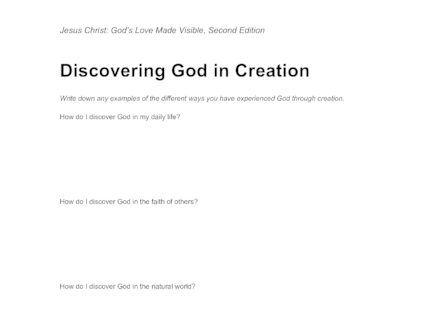
Students think of examples when they have experienced or discovered God in creation.
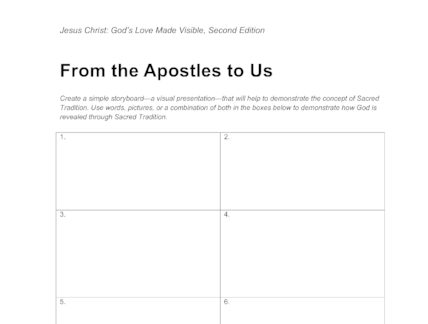
Students create a storyboard to show how God is revealed in Sacred Tradition.
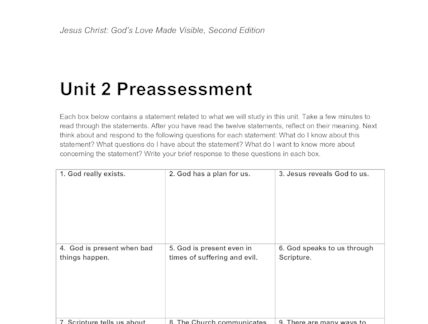
This preassessment helps students identify what they know and want to know about concepts from Unit 2.
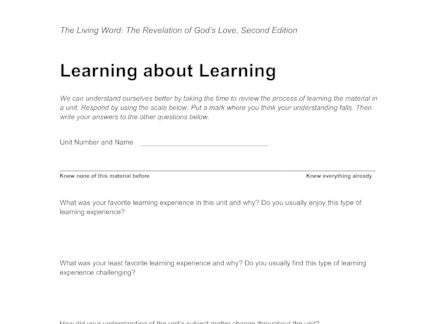
This handout asks a series of questions to help students reflect on and evaluate the learning in a particular unit.
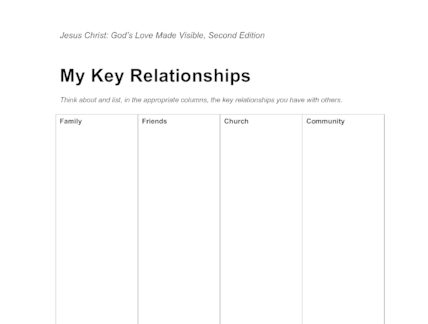
This handout provides a chart for students to list key relationships that are from their church, community, family, and friends.
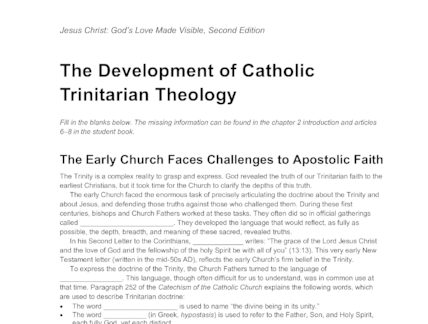
This worksheet has students fill in blanks from Chapter 2, Section 6-8, focusing on the faith changes during the early Church centered on the Trinity.
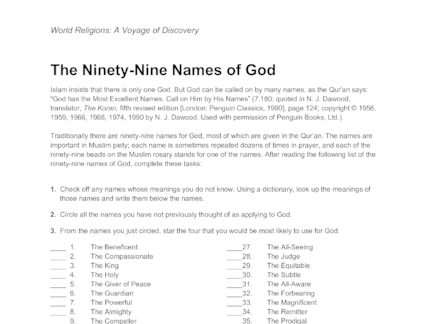
This handout lists the ninety-nine Islamic names for God and poses several questions regarding the list.
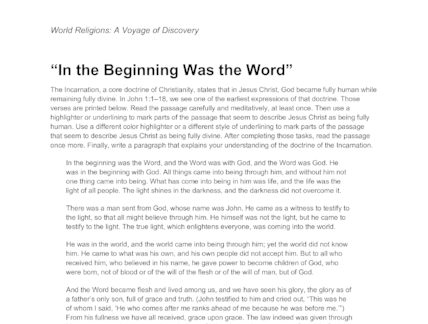
After presenting John 1:1-18 from the Christian Bible, this handout challenges to students to identify key parts that describe the doctrine of the incarnation.
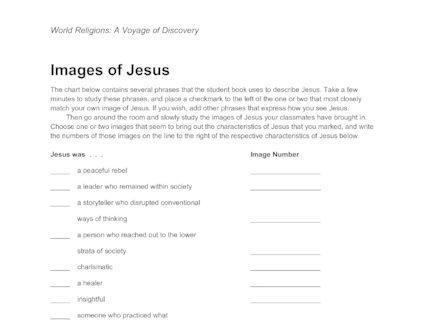
This handout provides many different images and descriptions of Jesus for students to examine and relate to.
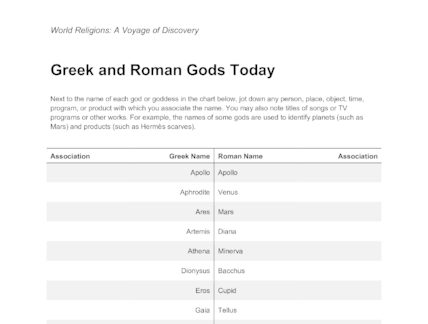
This handout challenges students to identify the associations they have with Greek and Roman gods.
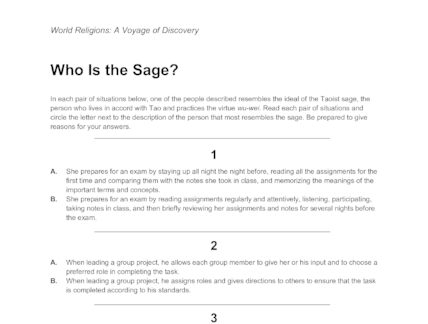
This worksheet provides the opportunity to choose life situations that exemplify practices of the Taoist sage.
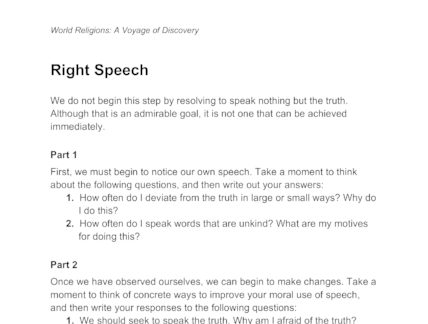
This handout provides a reflection on students’ use of words and speech. Students identify ways to improve their use of words to speak truth and kind things.
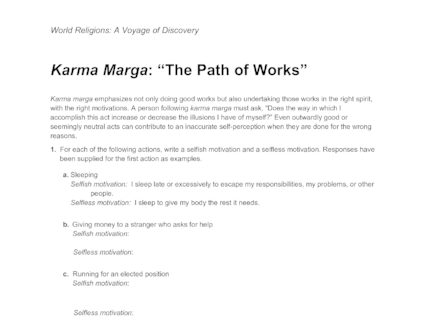
An individual worksheet that examines the intentions and motivations behind one’s actions.
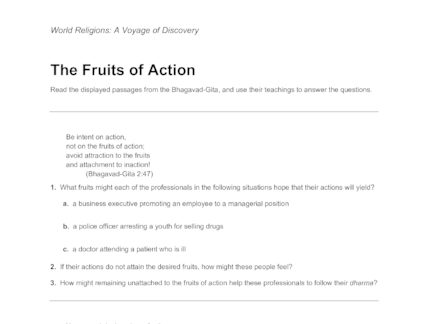
An individual worksheet that challenges students to apply teachings from the Bhagavad-Gita to real-life situations.
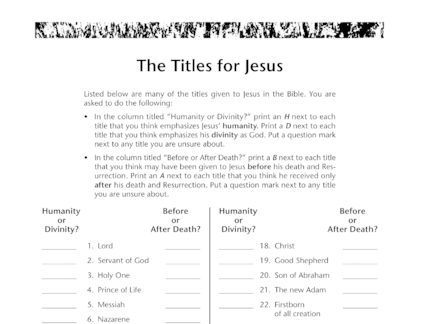
This worksheet presents a list of names for Jesus taken from Scripture. Students examine the meaning and purpose for each title.
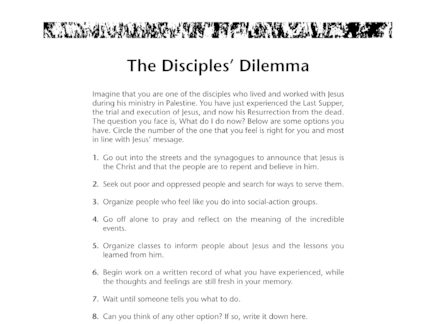
This handout challenges students to decide how they would have reacted as a disciple after Jesus’ trial, death, and resurrection
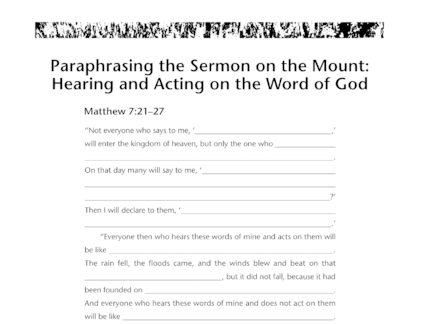
This handout allows students to complete statements from Jesus’ Sermon on the Mount
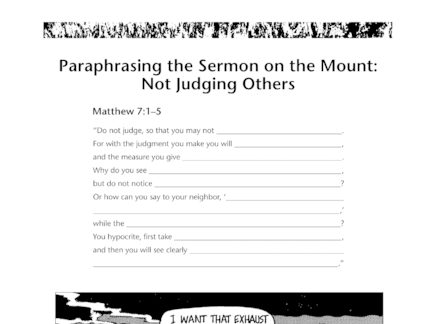
This handout allows students to complete statements from Jesus’ Sermon on the Mount
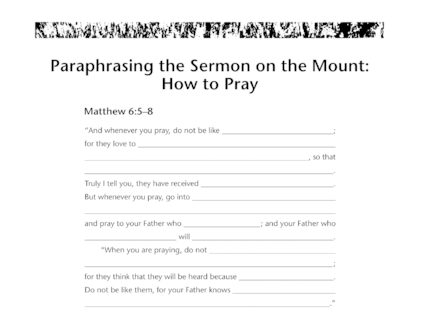
This handout allows students to complete statements from Jesus’ Sermon on the Mount
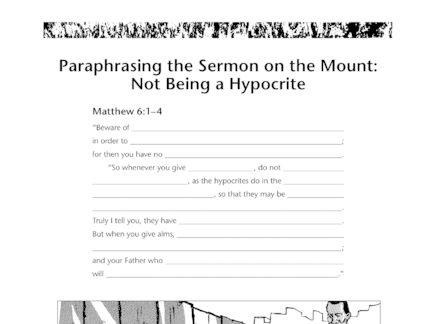
This handout allows students to complete statements from Jesus’ Sermon on the Mount
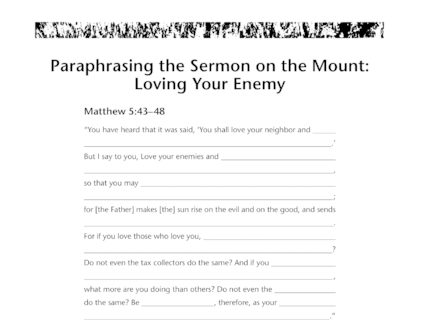
This handout allows students to complete statements from Jesus’ Sermon on the Mount
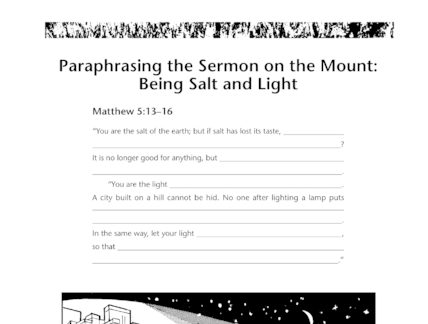
This handout allows students to complete statements from Jesus’ Sermon on the Mount
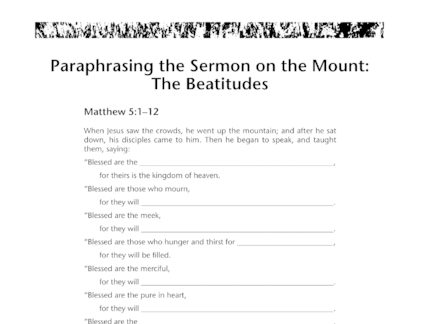
This handout allows students to fill in the blanks as they examine the Beatitudes
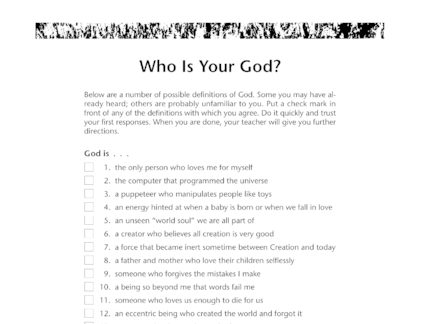
A reflective worksheet where students identify meaningful definitions of God
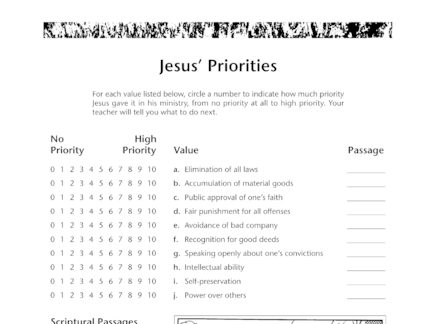
An individual worksheet where students rank the priority Jesus placed on certain values in his ministry
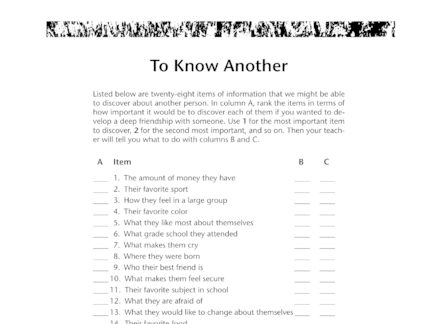
An individual worksheet where students rank the importance of discovering specific types of information about another person
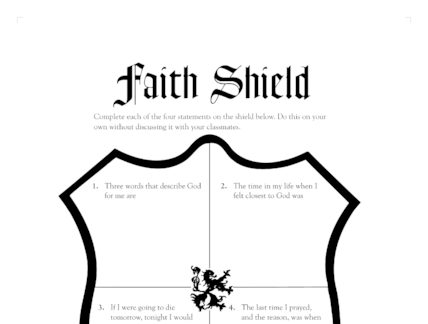
An individual activity that asks students about their faith and their relationship with God.
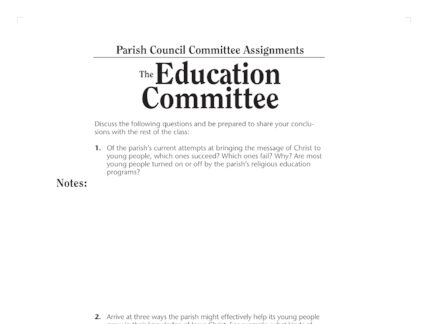
This handout assigns students to a made-up Parish Council Committee. Students must then brainstorm ideas and activities to help engage young people in the life of the parish.
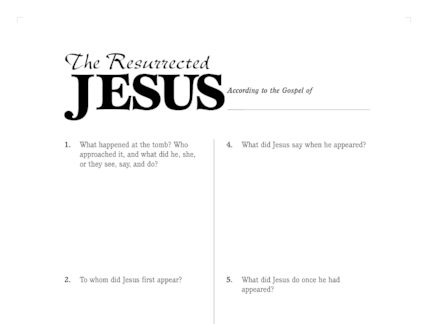
Students answer questions about the story of Jesus' Resurrection from one of the four Gospels.
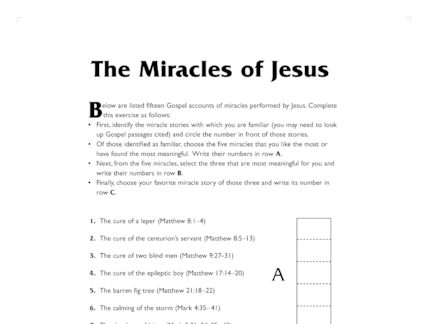
Students review many familiar miracles performed by Jesus in the gospels before choosing a favorite.
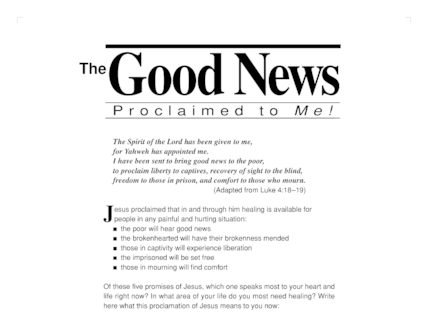
This handout asks students to reflect and write about the ways that Jesus' healing is needed in their lives.
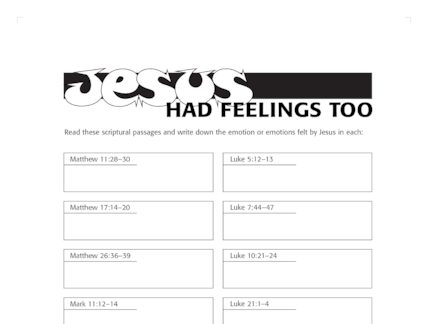
Students read passages from the Gospels to explore the numerous emotions that Jesus experienced during his time on Earth.
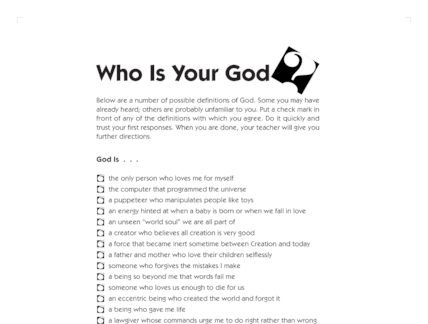
This handout presents a list of different definitions and identities for God. Students are asked to choose ones that resonate with them.
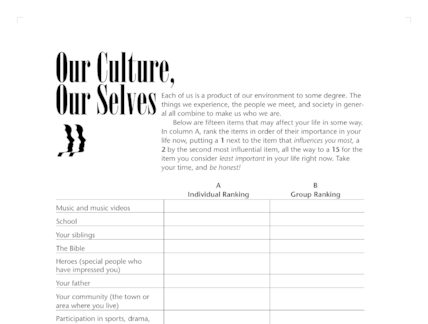
This handout asks students to rank a list of items in life and society according to their importance.
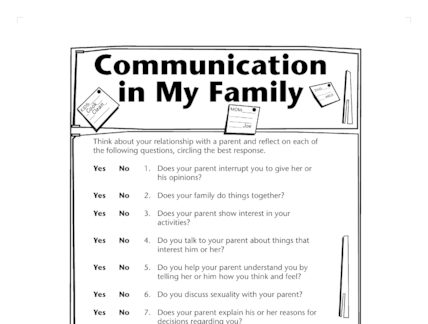
This handout helps students to explore the communication and relationship they have with their parents by asking a series of reflective questions for students to answer.
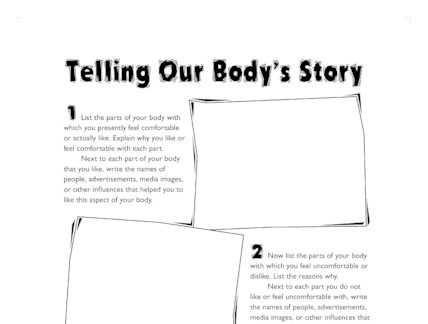
This handout helps teens reflect on their body image and the influences on their attitudes towards their bodies.
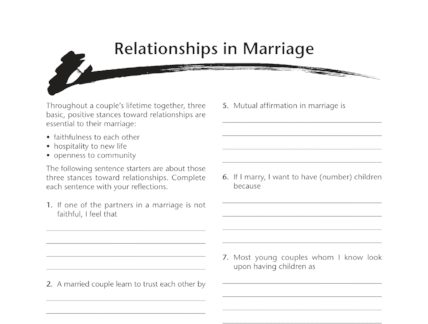
This handout presents numerous questions about healthy, life-long marriages for students to think about and answer.
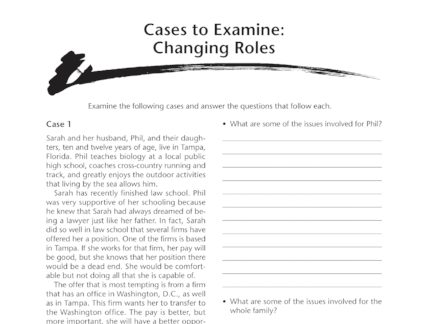
This handout presents several real-life family situations about which students must evaluate and make a decision.
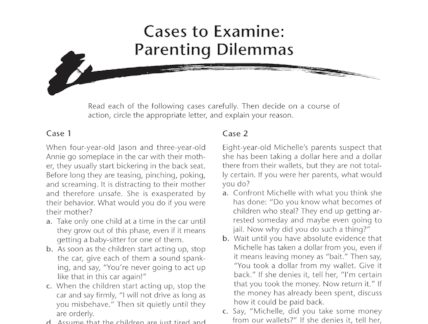
This handout provides several examples of parenting dilemmas. Students are to read the situations, choose a course of action, and explain their thoughts.
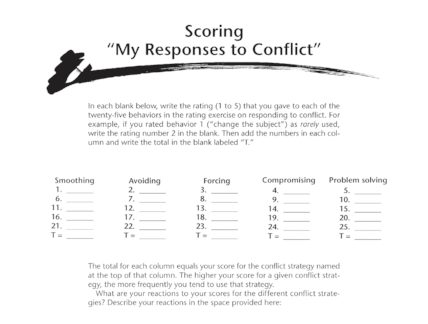
This handout provides the scoring that should be used to interpret the accompanying Handout 9-D.
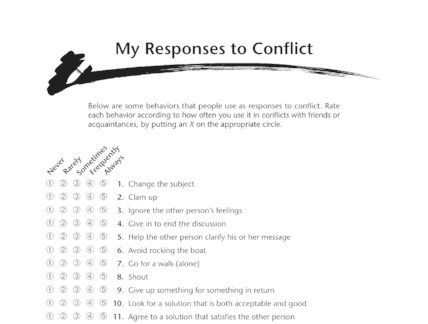
For this worksheet, students choose which behaviors match how they typically respond to conflict in relationships.
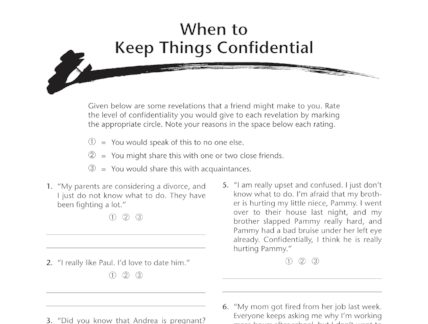
After reading several pieces of information that might be shared by a friend, students decide which should be kept confidential and which might be shared with others.
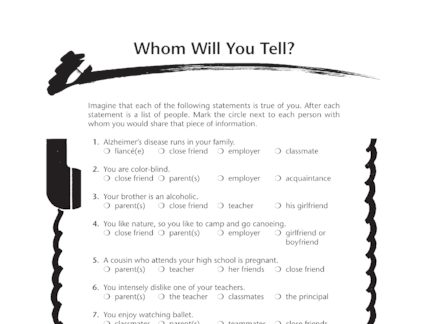
Students identify with whom in their life they would share a list of personal pieces of information.
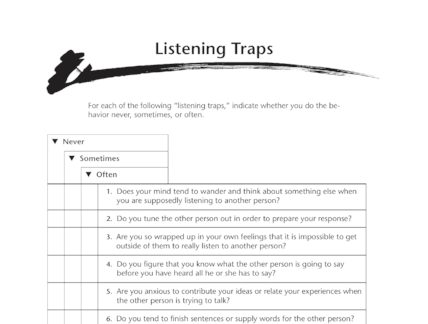
Students reflect on and answer a series of questions about their listening skills.
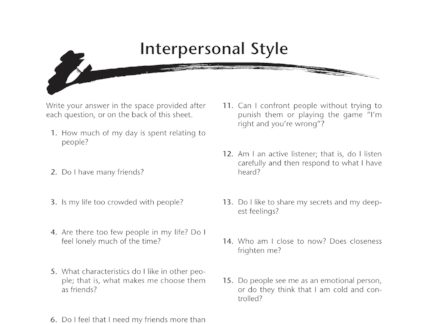
Students reflect on and answer a series of questions about their interpersonal style and relationships with others.
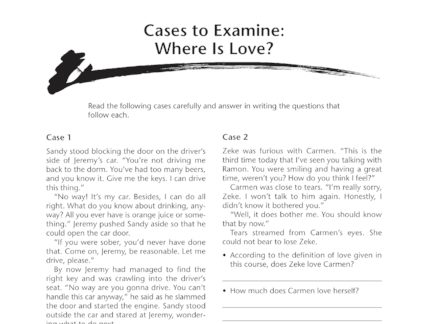
Students read and respond to several stories about what it means to love yourself and others.
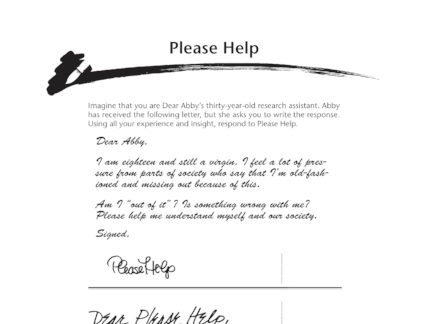
This is a writing prompt to help students reflect on what it is like to be a virgin in society today.

This handout provides a list of True/False statements about sexually transmitted diseases and AIDS.
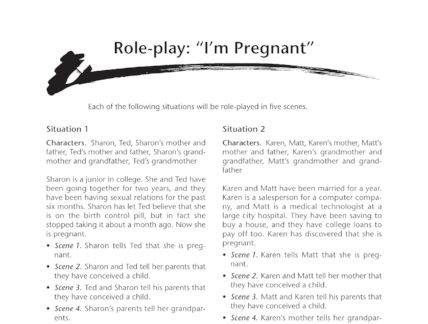
This handout provides two role-play situations in which a couple has discovered they are pregnant.
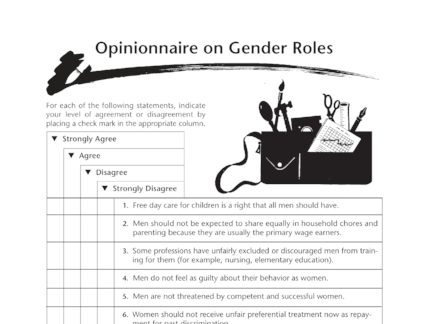
Students share their opinions in response to a series of statements about gender roles in society.
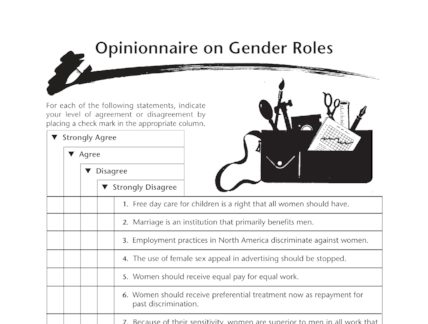
Students share their opinions in response to a series of statements about gender roles in society.
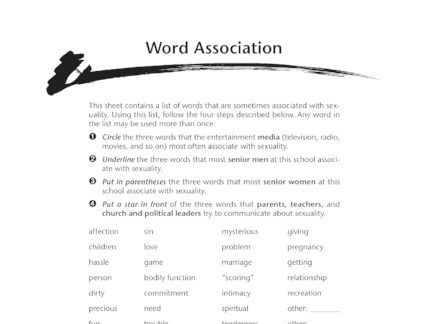
Students identify the different associations with and meanings of sexuality as portrayed in the media, by peers, and from adults.
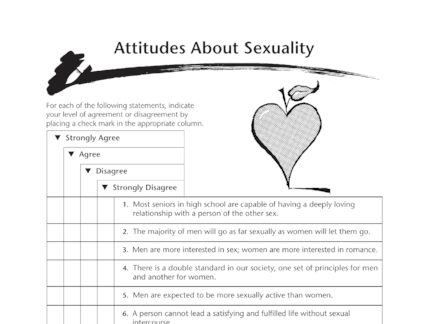
This handout presents a series of statements about sexuality. Students are to indicate their level of agreement or disagreement with each.
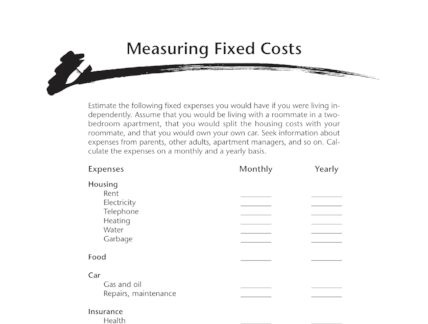
On this handout students calculate the fixed expenses of an independent adult on a monthly and yearly basis.
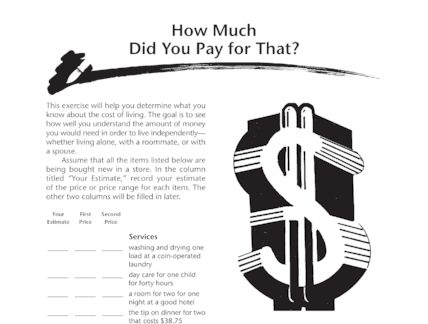
Students estimate the cost of a list of items needed to live independently. This exercise is meant to help students understand the amount of money needed to survive.
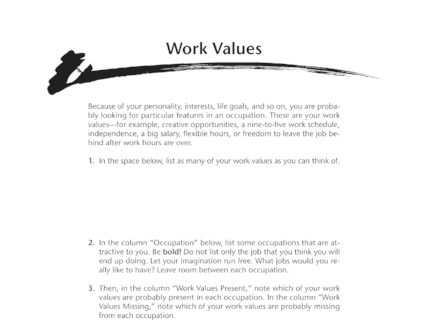
On this handout students explore the qualities they look for or want in a job and brainstorm possible jobs that fit those qualities.
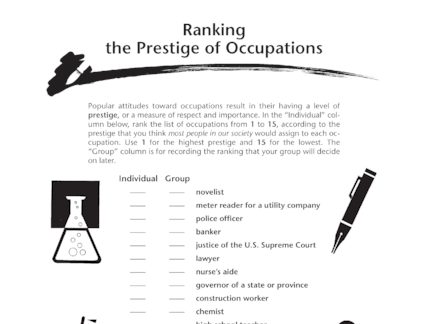
Students rank a list of careers based on their importance and prestige in society.
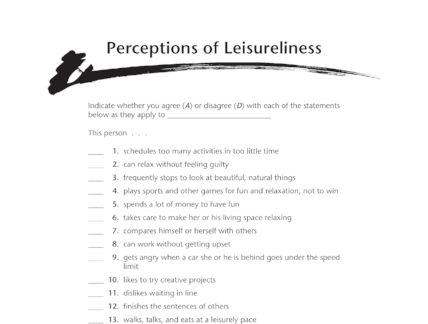
This handout provides a list of statements designed to help students evaluate the leisureliness of a specific person.
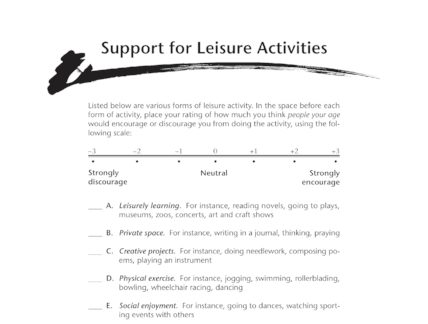
This handout asks students to decide which types of leisure activities their peers encourage them to participate in.
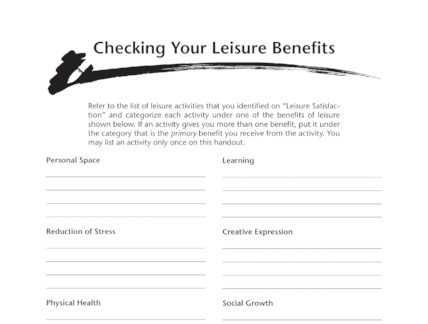
Students categorize their favorite leisure activities based on the primary benefit they receive from each.
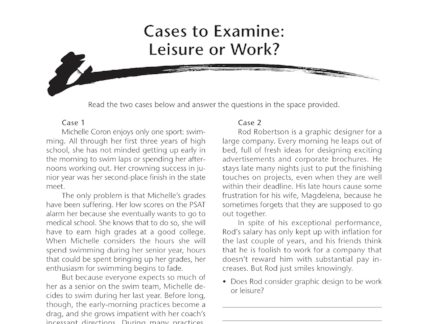
This handout presents two real-life scenarios for which students must read and answer questions.
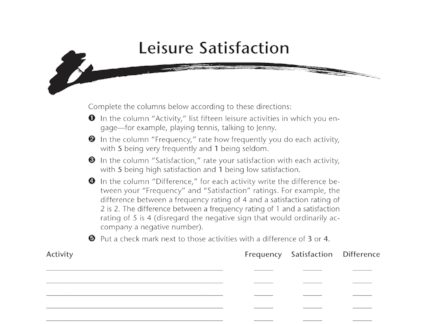
Students list leisure activities in which they participate before rating the frequency and satisfaction for each.
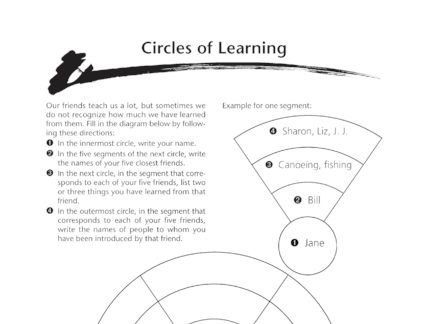
This handout provides a diagram for students to fill in as they reflect on the impact of friendship and relationships.
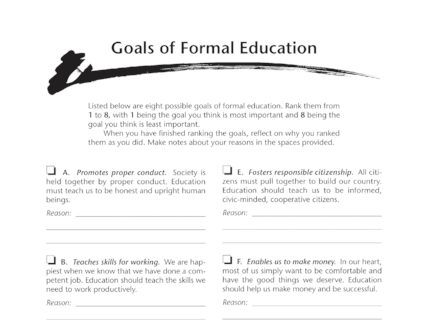
Students rank eight possible goals of formal education based on their importance or relevance.
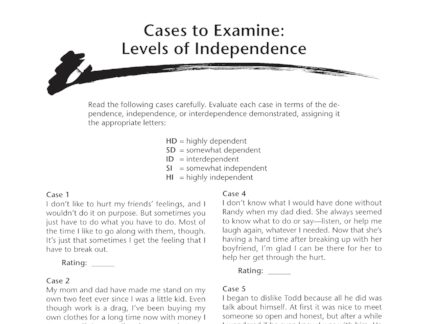
Students read several scenarios and rank the level of independence demonstrated.
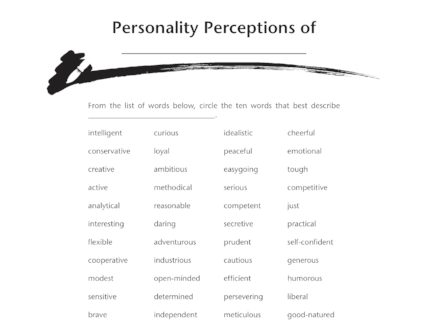
Students choose adjectives from a list to describe a specific person.
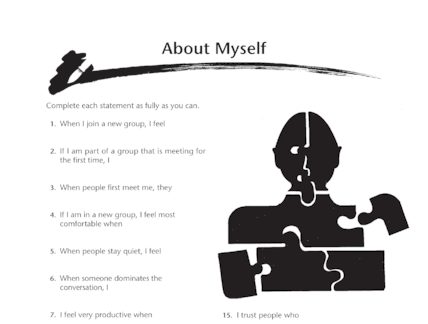
This handout provides a series of questions for students to answer about themselves.
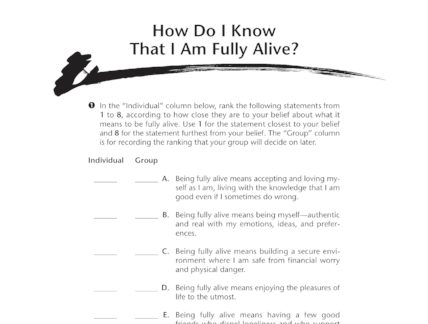
This handout asks students to rank statements according to their beliefs about what it means to be fully alive.
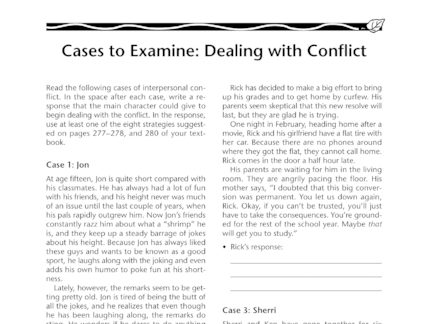
This handout provides three situations for students to read and evaluate. Students must give a suggestion for how to respond to the conflict in each scenario based on the strategies in the book.
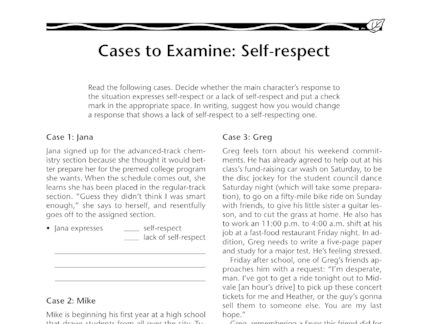
This handout provides three situations where teenagers are not fully respecting themselves. Students read the situations and respond with suggestions that demonstrate more self-respect.
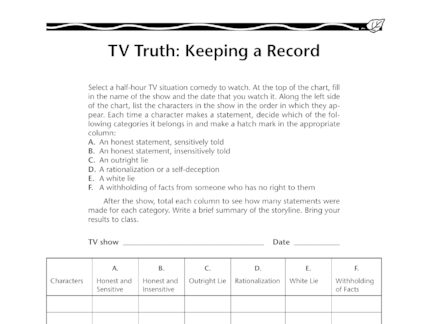
This handout provides a chart to help students keep track of the types of truths and lies portrayed on TV.

This handout provides a chart to help students keep track of their expenditures during one week
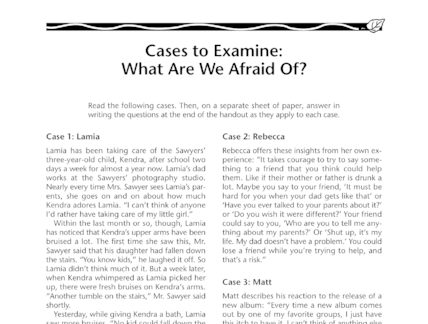
Students read several real-life scenarios and explore the many fears, anxieties, and pressures that influence decisions.
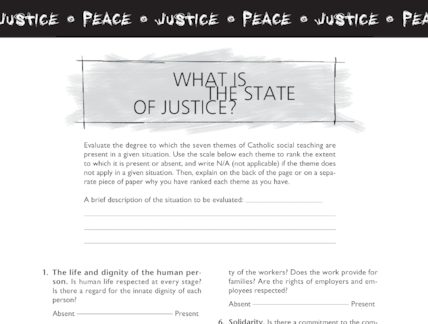
Evaluate the degree to which the seven themes of Catholic social teaching are present in a given situation. Use the scale below each theme to rank the extent to which it is present or absent, and write N/A (not applicable) …
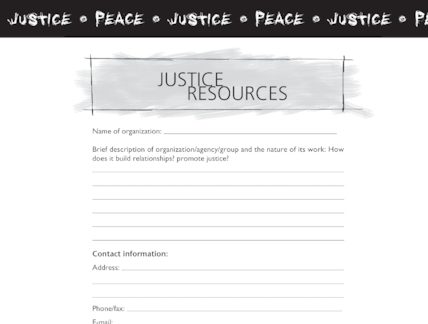
Brief description of organization/agency/group and the nature of its work: How does it build relationships? promote justice?
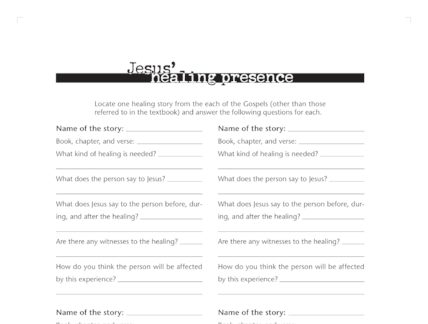
A worksheet that asks students to locate and answer questions about a healing story from each of the Gospels.
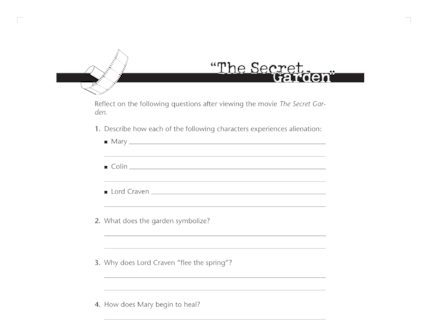
A set of questions that can be used to reflect on the movie “The Secret Garden,” a film that is an excellent example of reconciliation.
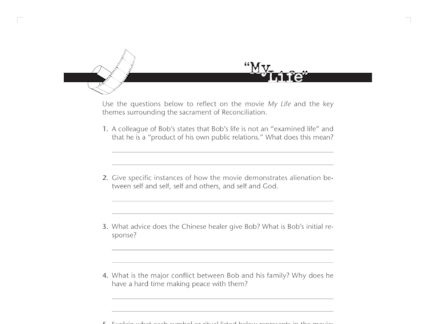
A set of questions that can be used to reflect on the movie “My Life” and the key themes surrounding the sacrament of Reconciliation.
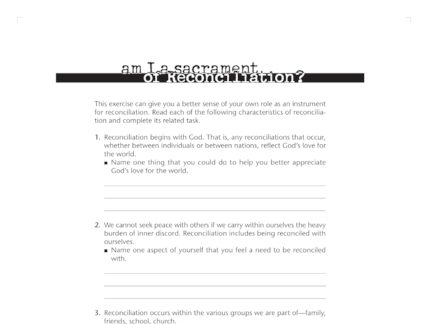
This exercise can give students a better sense of their role as an instrument for reconciliation.
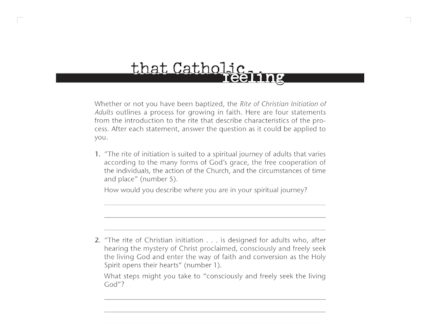
Whether or not you have been baptized, the Rite of Christian Initiation of Adults outlines a process for growing in faith. Here are four statements from the introduction to the rite that describe characteristics of the process. After each statement, …
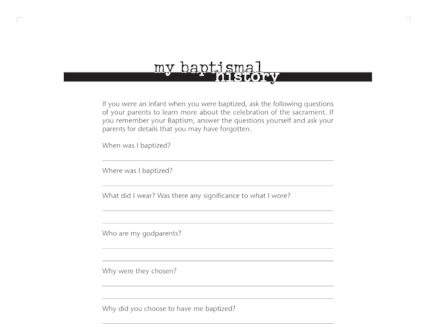
If you were an infant when you were baptized, ask the following questions of your parents to learn more about the celebration of the sacrament. If you remember your Baptism, answer the questions yourself and ask your parents for details …
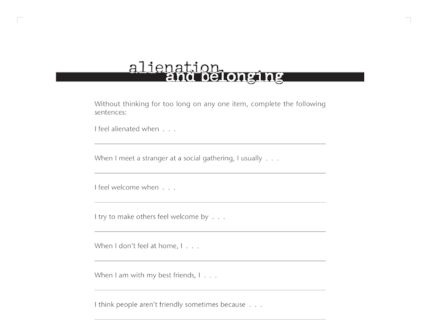
Without thinking for too long on any one item, complete the following sentences.
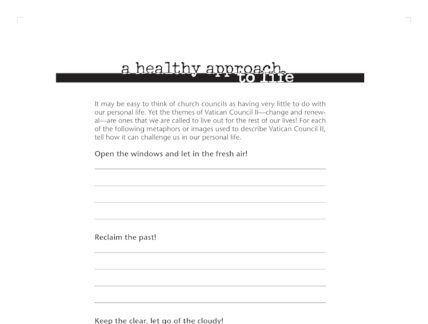
It may be easy to think of church councils as having very little to do with our personal life. Yet the themes of Vatican Council II—change and renewal—are ones that we are called to live out for the rest of …
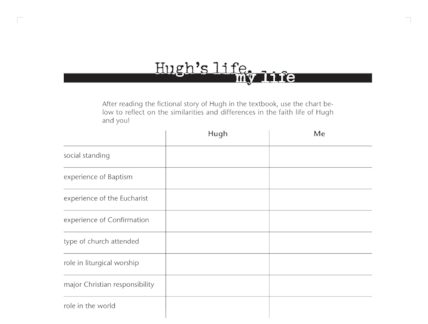
After reading the fictional story of Hugh in the textbook, use the chart below to reflect on the similarities and differences in the faith life of Hugh and you!
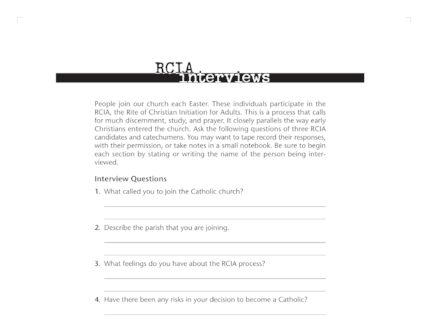
People join our church each Easter. These individuals participate in the RCIA, the Rite of Christian Initiation for Adults. This is a process that calls for much discernment, study, and prayer. It closely parallels the way early Christians entered the …
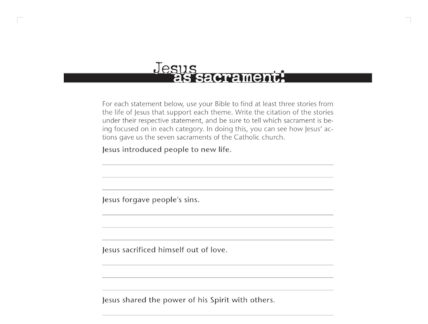
For each statement below, use your Bible to find at least three stories from the life of Jesus that support each theme. Write the citation of the stories under their respective statement, and be sure to tell which sacrament is …
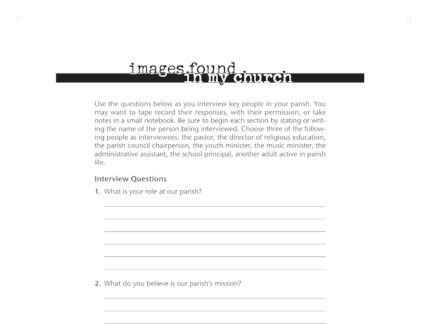
Use the questions below as you interview key people in your parish. You may want to tape record their responses, with their permission, or take notes in a small notebook. Be sure to begin each section by stating or writ-ing …
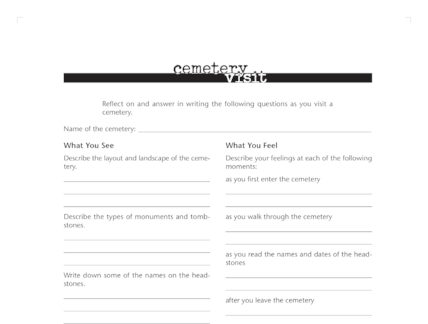
Reflect on and answer in writing the following questions as you visit a cemetery.
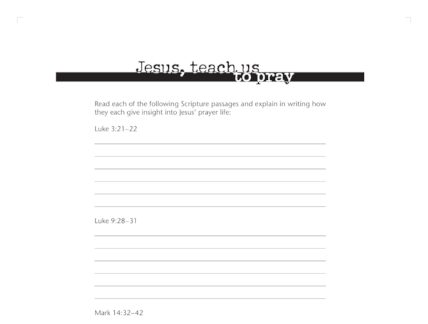
Read each of the following Scripture passages and explain in writing how they each give insight into Jesus’ prayer life.
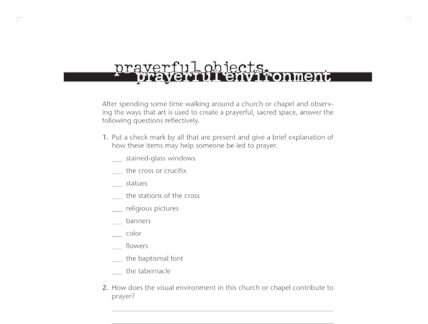
After spending some time walking around a church or chapel and observing the ways that art is used to create a prayerful, sacred space, answer the following questions reflectively.
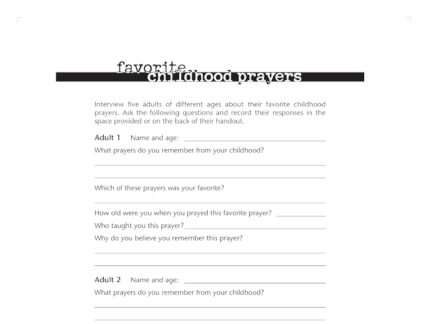
Interview five adults of different ages about their favorite childhood prayers. Ask the following questions and record their responses in the space provided or on the back of their handout.
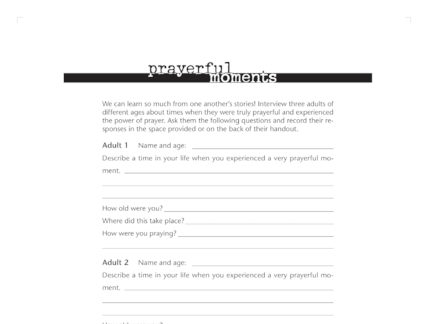
We can learn so much from one another’s stories! Interview three adults of different ages about times when they were truly prayerful and experienced the power of prayer. Ask them the following questions and record their responses in the space …
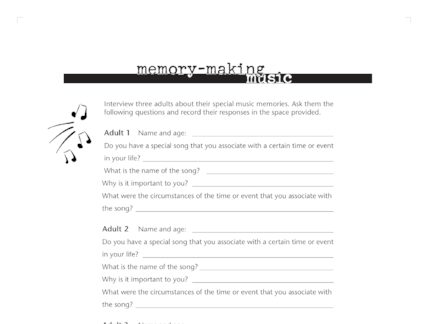
Interview three adults about their special music memories. Ask them the following questions and record their responses in the space provided.
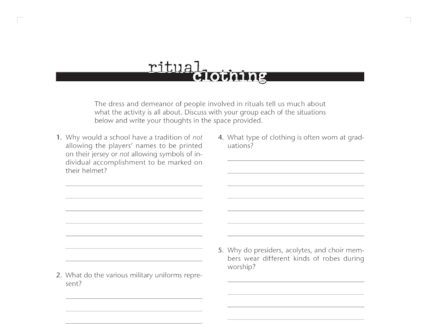
The dress and demeanor of people involved in rituals tell us much about what the activity is all about. Discuss with your group each of the situations below and write your thoughts in the space provided.
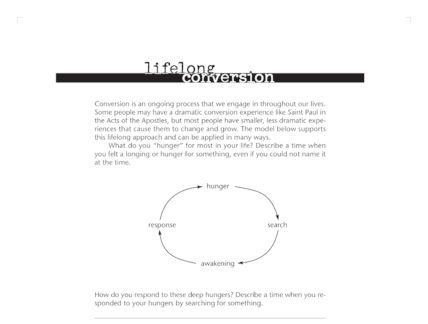
Conversion is an ongoing process that we engage in throughout our lives. Some people may have a dramatic conversion experience like Saint Paul in the Acts of the Apostles, but most people have smaller, less dramatic experiences that cause them …
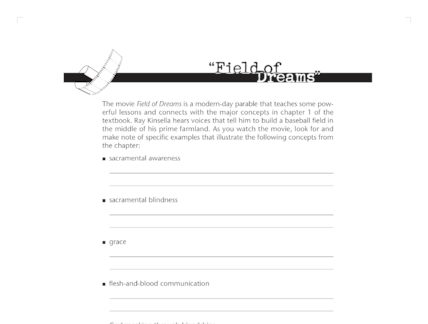
The movie Field of Dreams is a modern-day parable that teaches some powerful lessons and connects with the major concepts in chapter 1 of the textbook. Ray Kinsella hears voices that tell him to build a baseball field in the …
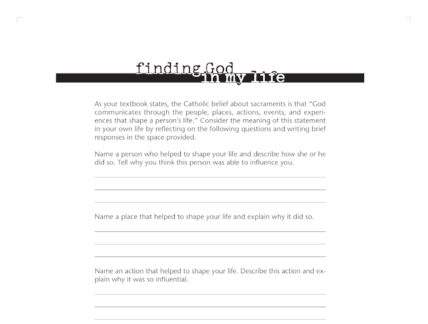
As your textbook states, the Catholic belief about sacraments is that “God communicates through the people, places, actions, events, and experiences that shape a person’s life.” Consider the meaning of this statement in your own life by reflecting on the …
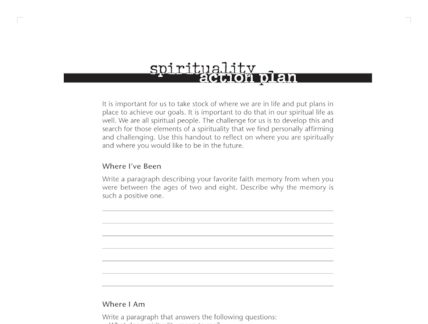
It is important for us to take stock of where we are in life and put plans in place to achieve our goals. It is important to do that in our spiritual life as well. We are all spiritual people. …
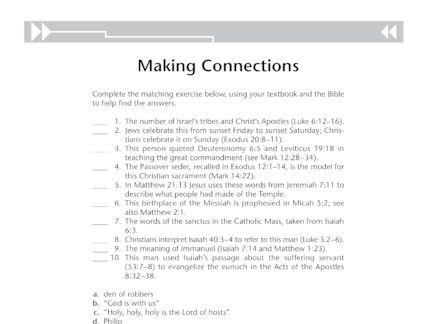
Complete the matching exercise below, using your textbook and the Bible to help find the answers.
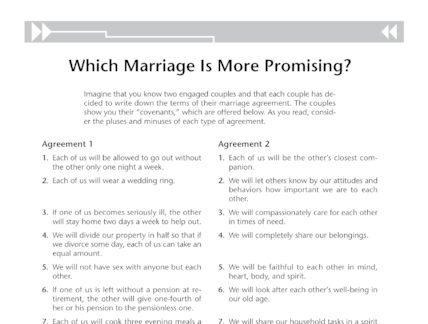
Imagine that you know two engaged couples and that each couple has decided to write down the terms of their marriage agreement. The couples show you their “covenants,” which are offered below. As you read, consider the pluses and minuses …
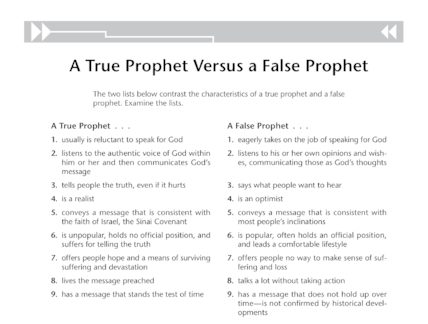
The two lists below contrast the characteristics of a true prophet and a false prophet. Examine the lists.
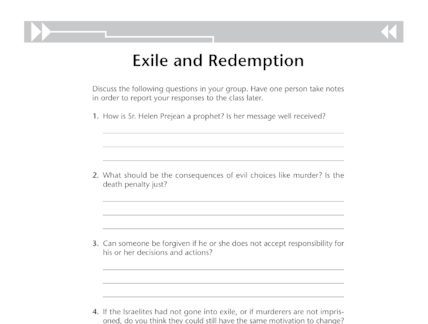
Discuss the following questions in your group. Have one person take notes in order to report your responses to the class later.
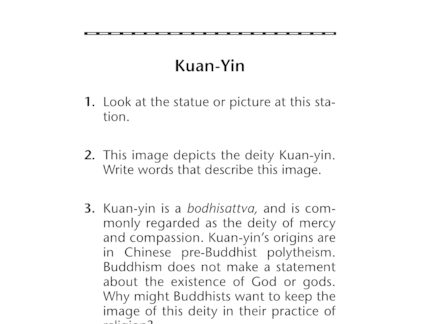
1. Look at the statue or picture at this station. 2. This image depicts the deity Kuan-yin. Write words that describe this image.
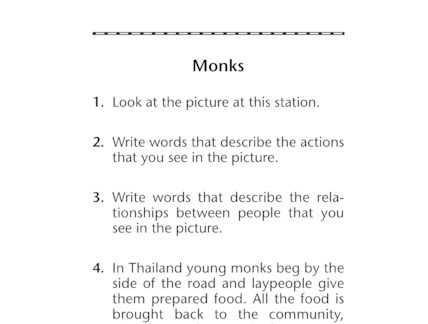
1. Look at the picture at this station. 2. Write words that describe the actions that you see in the picture. 3. Write words that describe the relationships between people that you see in the picture.
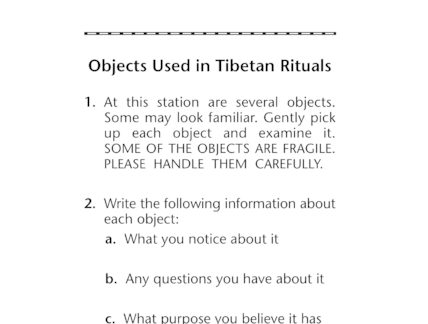
1. At this station are several objects. Some may look familiar. Gently pick up each object and examine it. SOME OF THE OBJECTS ARE FRAGILE. PLEASE HANDLE THEM CAREFULLY. 2. Write the following information about each object.
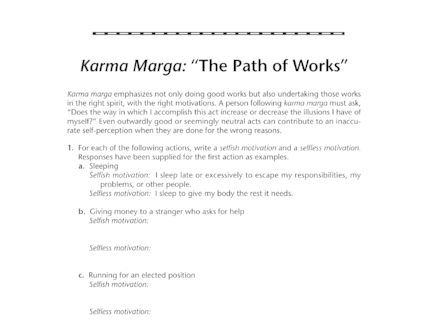
For each of the following actions, write a selfish motivation and a selfless motivation. Responses have been supplied for the first action as examples.
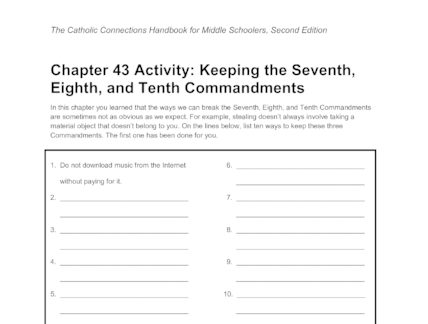
Students are asked to list 10 practical ways to keep the 7th, 8th, and 10th Commandments.
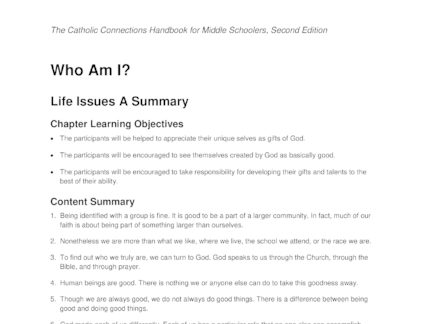
A summary of Life Issues from the Catholic Connections Handbook for Middle Schoolers, Second Edition.
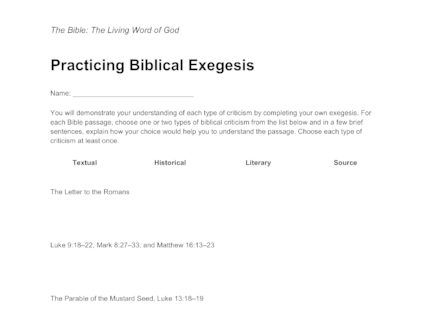
A worksheet where students are asked to demonstrate their understanding of biblical criticism by completing their own exegesis.